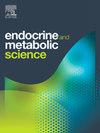矿化皮质激素受体拮抗剂减少独立于肌纤维矿化皮质激素受体的炎症信号
Q3 Medicine
引用次数: 0
摘要
慢性炎症是一种退行性横纹肌疾病杜氏肌营养不良症(DMD)的特征。矿盐皮质激素受体(MR)拮抗剂(MRAs)已被证明对晚发性DMD心肌病有临床益处,小鼠模型的临床前研究已证明对骨骼肌病理的多个步骤有效。mdx小鼠模型的MRA治疗降低骨骼肌髓系免疫细胞的促炎基因表达,抑制肌肉细胞因子信号传导和纤维化。mdx小鼠肌纤维特异性敲除MR可改善肌力并减少纤维化,但该模型中的炎症尚未研究。在这项研究中,我们在细胞水平上使用流式细胞术研究肌肉炎症,在蛋白质信号水平上使用无偏倚细胞因子测定。mdx小鼠和缺乏肌纤维MR的小鼠的髓细胞数量和比例相同,类似于之前在MRA治疗或髓细胞MR敲除中观察到的细胞类型差异的缺失。MRA治疗,而不是单独的肌纤维MR缺失,导致先前在mdx小鼠中观察到的许多细胞因子和趋化因子的减少。这些数据表明,来自mra的炎症信号的有益减少在很大程度上独立于肌纤维MR,并通过另一种机制发生。本文章由计算机程序翻译,如有差异,请以英文原文为准。
Mineralocorticoid receptor antagonists reduce inflammatory signaling independent of myofiber mineralocorticoid receptor
Chronic inflammation is a feature of Duchenne muscular dystrophy (DMD), a degenerative striated muscle disease. Mineralocorticoid receptor (MR) antagonists (MRAs) have demonstrated clinical benefit on later onset DMD cardiomyopathy, and preclinical studies in mouse models have demonstrated efficacy on multiple steps of skeletal muscle pathology. MRA treatment of the mdx mouse model reduces pro-inflammatory gene expression from skeletal muscle myeloid immune cells and represses muscle cytokine signaling and fibrosis. Myofiber-specific knockout of MR in mdx mice improves muscle force and reduces fibrosis, but inflammation in this model had not been investigated. In this study we investigated muscle inflammation at the cellular level using flow cytometry and at the protein signaling level using an unbiased cytokine assay. Numbers and proportions of myeloid cells were the same in mdx mice and those lacking myofiber MR, similar to the absence of cell type differences previously observed with either MRA treatment or myeloid MR knockout. MRA treatment, but not myofiber MR deletion alone, led to reductions in numerous cytokines and chemokines also previously observed in mdx mice. These data suggest that the beneficial reduction of inflammatory signaling from MRAs is largely independent of myofiber MR and occurs through another mechanism.
求助全文
通过发布文献求助,成功后即可免费获取论文全文。
去求助
来源期刊

Endocrine and Metabolic Science
Medicine-Endocrinology, Diabetes and Metabolism
CiteScore
2.80
自引率
0.00%
发文量
4
审稿时长
84 days
 求助内容:
求助内容: 应助结果提醒方式:
应助结果提醒方式:


